Robyn Dolan's Blog, page 10
September 26, 2016
Juicing in the Real World
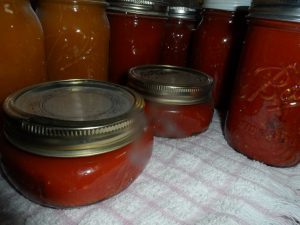
Most of us don’t have time for fruit and veggie prep, juicing and cleanup every day, several times a day. The gurus tell us to drink freshly juiced vegetables right away to get all the health benefits. True, this is the ideal.
You mothers who breastfeed and pump your milk at work understand how this works. You store and freeze your milk. It loses some vitamins, minerals, and enzymes. But your baby is still getting far more benefits from your breast milk than from formula. Even when that milk is reheated. We can’t always reach the ideal, but we do the best we can.
This is how I juice. Some enzymes, vitamins, and minerals do get lost in the storage and freezing process. But this is the real world, and I have other things to do besides be a slave to the juicer all day.
I go to the farmer’s market once or twice a week. If I can’t make the market I will buy fresh fruits and vegetables from the store, but the greens look fantastic at the farmer’s market lately, so I usually try and hit them up first. Usually, on farmer’s market day, I will come home and juice right away. The old stuff first, then the newer produce. I always save out enough for salads, snacks, and cooked veggies, then juice the rest.
I pour the fresh juice into canning jars, leaving about 1 inch of headspace for freezing. If you are going to try this, make sure you are using canning jars, not reusing mayonnaise jars or some other jars you got jam or something in. Canning jars are tempered to withstand temperature extremes. Every non-tempered jar I have tried freezing or canning with has cracked. That’s a lot of glass, food and hard work to throw out.
I keep about a quart of juice in the refrigerator at a time. When I thaw my juice, I do not use the microwave. The nutritional qualities of fresh juice are very delicate, and the freezing process has already destroyed some of them. So I let my juice thaw naturally, even if it means skipping a day of juice. It just takes some planning ahead. I will thaw frozen bone broth in the microwave, however.
Despite missing the ideal, I still realize enormous health benefits from juicing. I have more energy and am able to consume more fruits and veggies because of it.













The post Juicing in the Real World appeared first on Mrs. D's Traveling Homestead.
Published on September 26, 2016 09:27
August 29, 2016
Wild Fermentation

Wild Fermentation, by Sandor Ellix Katz
I love to preserve my homegrown bounty and I have also wondered how it was done before the advent of water bath and pressure canning in the 1800’s. Certainly people preserved foods long before rubber canning seals were invented. Sandor Katz digs deep into ancient preservation methods – primarily fermenting, and provides answers and most importantly, methods for this nutritious way of preserving.
From sauerkraut to sourdough, beer to yogurt, the history, culture that invented it and method of each type of ferment is explored. Katz supplies many anecdotes, both from his own family history and from the groups he studied to illustrate the fermenting process and even the enjoyment of the finished product. Some methods are complicated at best, but most ferments are surprisingly simple and Katz shares many recipes for fermenting and enjoying veggies, dairy, grains, and of course, beer and wine.
Health benefits of fermented foods are also explained and given new value. Dozens of recipes include: basic brining, sauerkraut, kimchi, miso, yogurt, farmer’s cheese and sourdough starter. Anyone looking for new/old ways to preserve food, while retaining as much of the nutrients as possible and making it more easily digestible, will find this book most informative and entertaining.
published in 2003 by Chelsea Green Publishing
90 recipes
208 pages
$20 www.wildfermentation.com













The post Wild Fermentation appeared first on Mrs. D's Traveling Homestead.
Published on August 29, 2016 19:52
Cure Tooth Decay
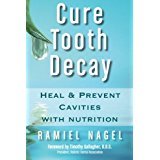
Cure Tooth Decay, by Ramiel Nagel
Dentist Weston A. Price did extensive research on nutritional factors of tooth decay in the 1930’s and 1940’s. Based on his findings, Ramiel Nagel set about healing his 3 year old daughter’s extensive tooth decay and met with great success. In Cure Tooth Decay, Nagel draws upon his family’s experience with the effects of improved nutrition upon their own dental (and physical) health as well as the research of other experts and the experiences of other families.
I have read Dr. Price’s work and appreciate the time and effort that the author has put into interpreting the dietary guidelines for tooth remineralization and stopping decay. I don’t agree with all his conclusions or suggestions, but his findings are interesting. This book helped make it easier for me to incorporate Dr. Price’s diet into my own lifestyle and also gave me new ideas for nutritional healing and reminders – like returning to using the water pik – for dental health.
I highly recommend Cure Tooth Decay to anyone looking for more information on proper nutrition and healthy dietary guidelines. I bought the Kindle version from Amazon.
Published by Create Space for http://www.amazon.com
252 pages
Recipe section
Kindle version $9.97 Paperback $26.97













The post Cure Tooth Decay appeared first on Mrs. D's Traveling Homestead.
Published on August 29, 2016 19:49
August 27, 2016
Secrets to Sneaking More Veggies into your Family’s Diet
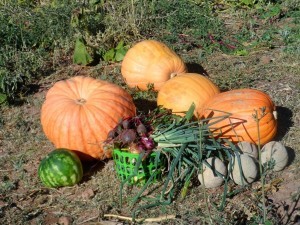
If your family is like mine, you’re lucky if you can get them to eat salad with dinner on a regular basis. French fries are counted as a veggie, and pizza is a full meal (meat, diary, bread, tomato sauce). Indeed, one of my sons honestly admits that the only way I’ll get him to eat more veggies is to hide them. So I do. Hence, today I am sharing my secrets to sneaking more veggies into your family’s diet.
Today we hear that raw is best for you. Although this may be true, even I can only eat so many raw veggies. And I like my meat and eggs cooked – medium rare, over easy, but cooked. Some veggies release their heavy duty disease fighting nutrients only after cooking. I’m thinking about tomatoes, onions and garlic, among others. So for the purpose of increasing my family’s fiber intake and nutrition, I serve lots of cooked veggies. They just don’t know about it.
Salad
Salad before dinner is a mainstay at my house. The more toppings, the better, and lots of ranch dressing. Despite the fact that most ranch dressing contains msg and soybean oil, I have had to concede that ranch is the vehicle to get the veggies ingested. One small victory at a time.
Smoothies
A banana, raw milk or yogurt, more fruit, a raw egg, and, um, kale? Lettuce? Well, you didn’t need to know about that. I can put more greens in mine, but for the fam, just a leaf or 2…
Fried
Stir fry or chow mein makes the table at least once a week. Cooked rice or noodles are lightly fried with carrots, onions, garlic and 3 or 4 other chopped vegetables. Use coconut oil for natural sweetness and add leftover meats or an egg if desired. Chop everything fairly small so that it doesn’t take long to cook. Also, ginger, garlic and turmeric help add an asian flavor.
Casserole
Another favorite one pot meal is the good ole’ casserole. Mix cooked rice, potatoes or noodles with chopped veggies and meats (if desired) and douse with cheese sauce. Or if you’re a canned soup person, cream of mushroom, chicken or celery soup. Season to taste and bake at 350F until done. This is easier with already cooked veggies and meats (aka, leftovers). Cauliflower hides real well, especially with cheese.
Tacos
Taco meat is a good place to hide veggies. Shred or cut them small and fry with the hamburger and onions. This works well with carrots, corn, zucchini, olives, chiles, bell peppers, tomatoes, etc. Moreover, adding veggies to your taco meat will stretch your meat budget further.
Spaghetti
Spaghetti sauce is very versatile. You can blatantly add chunks of zucchini, carrots and peppers, or you can shred or dice them. Use fresh tomatoes or canned sauce. This is delicious with or without meat. Don’t forget the onions and garlic.
Soup
Many people no longer consider soup to be a meal. In reality soup is a superfood. To say nothing of the wide variety of soups. Just think chicken broth, carrots, zucchini, corn, peas, green beans, broccoli, etc. for starters. Add some kind of fat for flavor. Butter, olive oil, and chicken fat all work well and help with digestion and nutrient absorption. Season to taste. Serve with a good bread and butter.
I hope I’ve sparked your imagination. There are tons more ways to sneak those veggies in. This is just to get you started. Now go feed your family more veggies!













The post Secrets to Sneaking More Veggies into your Family’s Diet appeared first on Mrs. D's Traveling Homestead.
Published on August 27, 2016 17:33
August 19, 2016
Life Without Refrigeration
![Life Without Refrigeration by [Gregersen, Susan]](https://i.gr-assets.com/images/S/compressed.photo.goodreads.com/hostedimages/1480553218i/21323649.jpg)
Could you live off-grid without a refrigerator? Susan Gregersen has for over 30 years. She wrote Life Without Refrigeration to share her experiences and tips for preserving food without benefit of a fridge. She explains how bacterial growth and spoilage occur, and why some foods need to be kept cold.
To start with, several chapters address places to keep food cool –
root cellar
evaporative cooler
snow cave
basements and crawl spaces.
She then devotes a chapter to alternative means of preserving food –
canning
dehydrating
salting.
With each method of storage or preservation, Ms. Gregersen offers examples of which foods are best suited for that method. I was particularly interested in the dairy and meat suggestions and found some new ideas for dehydrating that I plan to try. Especially cottage cheese and sour cream. Apparently it is possible. As another alternative, she gives information on commercial dried and canned meat, dairy and eggs, and alternatives. Raising meat and dairy animals is also an option.
I have stored food in my unheated workshop for many years with great success. Mostly canned, dehydrated, or dry goods, but also citrus and root veggies, wrapped in newspaper and put in boxes. It is very important to pay attention to signs of spoilage and know what kinds of storage or preservation are safe for the foods you are storing. Also how soon to use them.
Although Susan does not give detailed instructions for the projects offered, they serve as a springboard for ideas to further research.
To sum up, this book is a handy reference guide to all of the above, for the beginner. If you are looking for more advanced storage and preservation methods, such as for meat and dairy, it is a good jumping off point.
I bought Life Without Refrigeration from Amazon, Kindle Version. I did not receive any compensation for this review.
Life Without Refrigeration, by Susan Gregersen (c) 2013 82 pages
Available on Amazon $7.99 paperback, $3.99 Kindle













The post Life Without Refrigeration appeared first on Mrs. D's Traveling Homestead.
Published on August 19, 2016 17:43
August 13, 2016
Money Secrets of the Amish
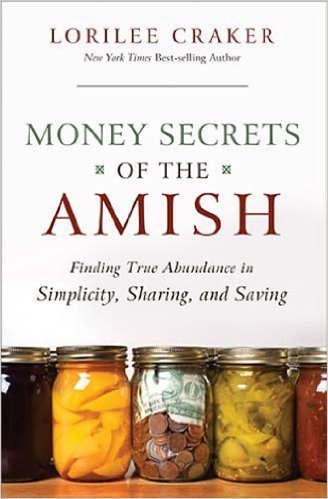
Money Secrets of the Amish, by Lorilee Craker is jam-packed with practical, down-to-earth wisdom from the Plain People. Probably most of us want to stop being slaves to money and start living the good life. The Amish have a reputation for living well on less, consequently, it might help to find out how they do it.
A “worldly” woman with a Mennonite background, Lorilee Craker is in a unique position to connect with the Amish. She introduces us to Amish farmers, housewives and church leaders, coaxing their secrets from them while sharing homemade artisan cheese and fresh garden veggies. As a result, she is able to provide insight for us into how this group of people thrives without credit cards, enormous mortgages, or six-figure incomes.
With amusing anecdotes and real-life stories, the author and her friends go from over-extended to simple and satisfied, all while making it look like common sense.
My grandma and mom endured the Great Depression, so my childhood abounded in these tried and true methods of acheiving abundance with very little. These suggestions have also helped me get back on track when I have foolishly overextended myself.
Chapters include:
delayed gratification
recycling
de-spoiling the kids
how the best things in life really are free
Amish style gift giving
what to and not to buy in bulk
the next best thing to growing your own food
how to barter
Lorilee ends each chapter with her own Amish Money Makeover tips, especially relevant for practical application in a non-Amish life. Money Secrets of the Amish is a great resource, first for rebooting your attitude and outlook on money and possessions. In addition, it provides simple, sensible instructions for putting that reboot into practice. A useful reference for every home library, with links to helpful websites, also.
I bought the Kindle version from Amazon. No compensation was received for this review.
Money Secrets of the Amish, by Lorilee Craker
(c) 2011
Published by Thomas Nelson
242 pages
Available on Amazon $11.34 paperback, $7.99 Kindle













The post Money Secrets of the Amish appeared first on Mrs. D's Traveling Homestead.
Published on August 13, 2016 05:27
July 15, 2016
When Water Doesn’t Run

What do you do when water doesn’t run through the pipes? We’re getting lots of practice with that one right now. Most people on city water just turn on the faucet and are rewarded with a pressurized flow. Out in the country and on the road, however, things get a little bit different.
At the Arizona homestead, we haul water and pump it into a 2500 gallon storage tank. From there, it runs through pipes to the water pump, then the pressure tank, and ultimately, the house. Unless a pipe breaks. Or the main valve breaks. Luckily, the main valve broke in the closed position. Unfortunately, the tank was full at the time. Consequently, I have not yet replaced the valve, mainly because that would involve draining all the water. Therefore, at the moment, we are filling jugs from the tank, for use in the house. This begets a whole new, yet old, definition of running water.
Kitchen sink supply:
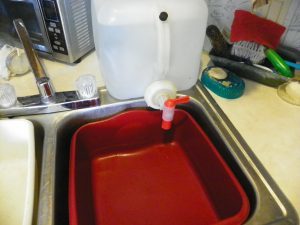
Water heater:
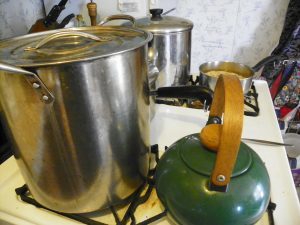
Bathrooms:
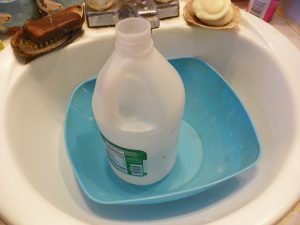

We have even splurged on a down-home swimming pool:
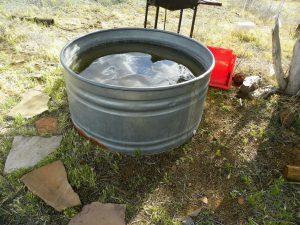
Still, the tank remains half-full. We’ll get there. Makes for good water conservation practices.
In the mobile homestead when water doesn’t run, due to a dead battery or converter, as is currently the case, we do pretty much the same thing. We just refill our water jugs from the drain valve on the fresh water tank.
Kitchen sink supply:
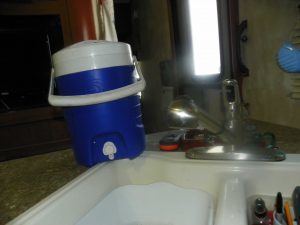
Water heater:
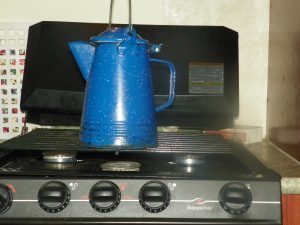
Bathroom:
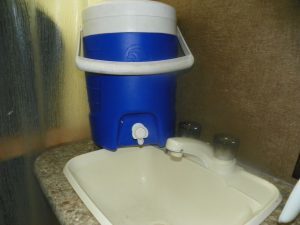
Refill:
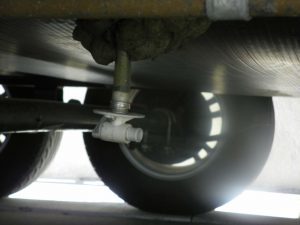
So all this has me thinking about what we would do at the urban homestead when water doesn’t run. First we would need a water supply. Probably 55 gallon drums. Then the rest would be just as above. We would simply have to train our city family to reuse the gray water for flushing and such. But probably, if it came to it, they would do just fine.
What will you do when water doesn’t run?













The post When Water Doesn’t Run appeared first on Mrs. D's Traveling Homestead.
Published on July 15, 2016 17:08
June 30, 2016
How to Write an Essay

Today I have a guest post, How to Write an Essay, from my son, Yak. This is actually, from a couple of months ago. I wanted to give him incentive to improve his writing, so we started polishing up his work to post on our blogs, and send out for publication. I only suggest corrections to his work, I don’t rewrite it for him. This is all his, including the title. Enjoy!
In this essay I will teach YOU how to write a half-decent essay!
Basic Requirements: Name, Date, Essay Name, 3 Paragraphs, Exit Paragraph.
Read the basic requirements! That is the basic way to create a simple essay! You can get more complicated with more paragraphs or maybe mixing up some stuff! You can create really complicated essays by using the simple requirements! You can create stuff to make money, earn reputation and more stuff like that!
So that about covers the basics! You can create epic essays the more you practice! You can create essays about gaming, outside life, animals, everything and anything! You can create so many things! You can even write a short story about some old person living in a shack in the woods! You never know what you can create out of a Microsoft word document and a keyboard!!!!!!
I should get to wrapping this essay up, but feel free to subscribe to my youtube: Golden Ore Gaming, Twitter: Golden Ore Gaming, Facebook: NONE, Instagram: NONE, and feel free to write essays about the object of your hearts desire! I really love to make these little essays about random things! Remember to check out some awesome games I found recently on the internet: Slime Rancher, Scrap Mechanic, Subnautica, The Elder Scrolls V: Skyrim, Undertale and Beseige! You can purchase all these games at: Steampowered.com
Cya!
Yak













The post How to Write an Essay appeared first on Mrs. D's Traveling Homestead.
Published on June 30, 2016 11:37
June 10, 2016
Planning for High School

We have been planning for high school for several months, now. Yak, currently taking a fun break, will spend a couple more months in “8th grade”, then start “9th grade” in or around September. According to conventional standards, he should be in 8th grade in September. The beauty of homeschool is not having to bow to conventional standards. Some may ask how I determine his grade level. I pretty much go by the math book, as his abilities are all over the board. To take a standardized test would just defeat the purpose.
To place him in high school now, is to give him a challenge that he is ready for. More targeted studies. Preparing to decide if he will continue to study in college/university or learn a trade. Or start a business. To give him the responsibility to choose a direction and explore it in detail.

He will continue with Algebra and higher math, but also complete a consumer math course. He will continue with daily essays and reading. He will start to look at different career paths and explore courses and activities related to them. He will start practicing for the SATs. We are using High School of your Dreams, by Nancy Nicholson, available through Catholic Heritage Curriculum as a rough guideline. It provides general information on credit hours required for each subject, to qualify for “graduation”. We will use that guideline and Yak’s SAT scores to determine when he is ready to “graduate” high school.
There are many tools available online to put together transcripts. We have also been keeping records, a portfolio of Yak’s work, and lots of pictures and videos of his projects. We will continue this record keeping, so that he will have a detailed portfolio and transcripts when and if he applies to colleges.
Right now, though, we’re enjoying a couple weeks of summer break before hitting the books again.













The post Planning for High School appeared first on Mrs. D's Traveling Homestead.
Published on June 10, 2016 15:15
Robyn Dolan's Blog
- Robyn Dolan's profile
- 1 follower
Robyn Dolan isn't a Goodreads Author
(yet),
but they
do have a blog,
so here are some recent posts imported from
their feed.



